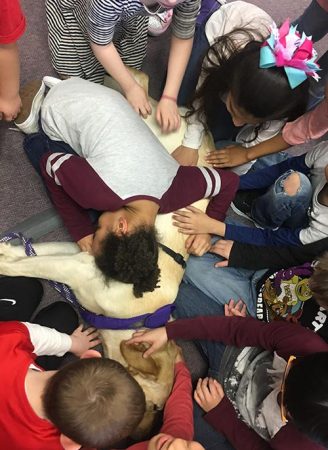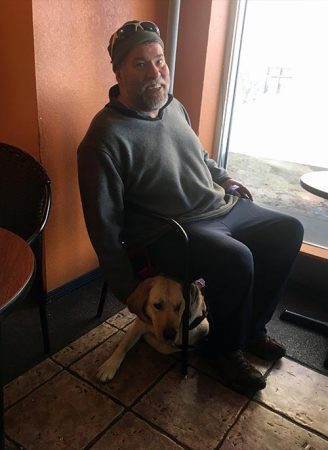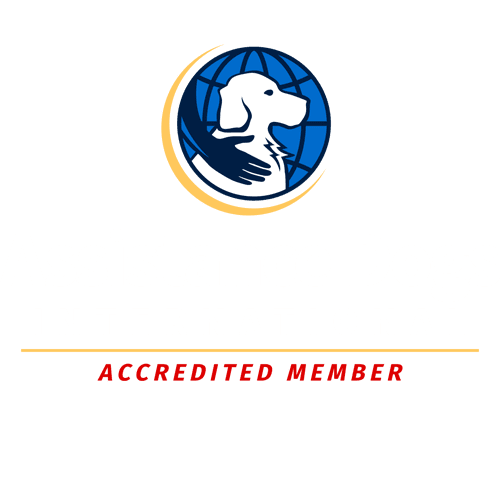Service and Facility and Specialist Therapy Dogs,…Oh My!
“To Each Her/His Own”
We are often asked, “How do you select dogs for specific assistance dog work?” Paws for Purple Hearts trains and places three different types of assistance dogs: Service Dogs, Facility Dogs, and Specialist Therapy Dogs. At Paws for Purple Hearts, we work exclusively with Golden retrievers, yellow Labrador retrievers, black Labrador retrievers, and Golden/lab crosses.
So, how do we know which dogs will excel in which career? Well, the answer is simple…the dogs tell us! Throughout their training, we observe the dogs closely and keep in mind their strengths and challenges. Does the dog have a strong work ethic or would the dog rather be petted and hugged than retrieve socks or push the elevator button? Does the dog bond easily and strongly with one trainer or is the dog easily transferred from trainer to trainer?
Across the board, we look for dogs with low to mid arousal levels and low prey drive. Dogs that are human-oriented and not reactive to other animals, people, and external stimuli such as loud noises and movement are the best candidates for assistance dog work. For example, automatic doors and flags waving on a windy day can distract a working dog from the job. We also look for dogs that are in tune with their human partner(s).
Service Dogs
Paws for Purple Hearts Service Dogs are trained specifically to mitigate the effects of three disabilities: Post-Traumatic Stress Disorder (PTSD), which includes combat-related PTSD and Military Sexual Trauma; Traumatic Brain Injury (TBI), and Mobility Impairment. Service Dogs must be good problem-solvers and, depending upon the lifestyle and needs of the Warrior (Veteran or Active Duty Service Member), the dog can be low or mid-aroused. A Warrior with PTSD who loves to ski and go running will be better matched with a mid-aroused dog, whereas a Warrior with Mobility Impairment who uses a wheelchair and works 40 hours/week in an office might be better matched with a low-aroused dog. Service dogs must be impeccably behaved in public and remain unobtrusive while their partners go about their daily activities.
The best candidates for Mobility Service Dogs are those with a high work ethic; the dogs that love to perform tasks like opening the refrigerator and retrieving medications or a water bottle. Dogs that are larger in size are best for commands like “brace”, which cues the dog to maintain a strong stance while the handler puts weight on the dog’s shoulders and hips to assist with transferring from the floor or a bed to a wheelchair. A large dog will be able to reach the light switch on the wall and the button for the elevator and at pedestrian crossings. These dogs must be ready to work when requested, and ready to rest patiently when their assistance is not needed.

Facility Dogs & Specialist Therapy Dogs
A successful facility dog or specialist therapy dog is human-friendly and enjoys interacting with a wide variety of different people, from young children to older adults. These dogs are not body-sensitive, in other words, these dogs love to be touched, petted and hugged all over their bodies and do not shy away from strangers. A low-aroused dog is a good candidate for Facility Dog or Specialist Therapy Dog if the setting involves a dog lying around throughout most of the day to be petted as necessary as in a therapist’s office or clinic. A mid-aroused dog would be a better candidate if the dog’s job involves visiting several people in a group, such as in a group therapy setting or a VA hospital. In some cases, Facility Dogs may work off-leash in a building or office, so we also choose Facility Dogs that are capable of working independently and enjoy initiating contact and interaction with patients on their own.

A Specialist Therapy Dog has one primary handler throughout the dog’s working life and may work in one setting or several different settings alongside the main handler, whereas a Facility Dog may have a few primary handlers who may change throughout the dog’s working life. For example, if a Facility Dog works in a VA hospital and the primary handler transfers to a different site, the dog will likely remain in the original facility, but the primary handler(s) may change throughout the dog’s career. If a Specialist Therapy Dog’s primary handler changes employment or transfers to a different site, the dog typically remains with the primary handler across settings. Thus, a Facility Dog must be able to bond with several different primary handlers, whereas a Specialist Therapy Dog will remain with the initial primary handler throughout the dog’s working life. On the other hand, a Specialist Therapy Dog must be adaptable to several different settings, whereas a Facility Dog only needs to be comfortable in one place as the dog will remain in the original setting throughout the dogs’ working life.
Another element of a Specialist Therapy Dog’s work that is different than a Facility Dog is that the Specialist Therapy Dog is utilized by his or her handler in a specific way to achieve certain documented treatment goals with the handler’s patients. Thus, a Specialist Therapy Dog may be asked to perform certain tasks or work in certain ways on command in order to facilitate a patient’s treatment; whereas, a Facility Dog generally is available for more informal interaction.





 Combined Federal Campaign (CFC) #43093
Combined Federal Campaign (CFC) #43093